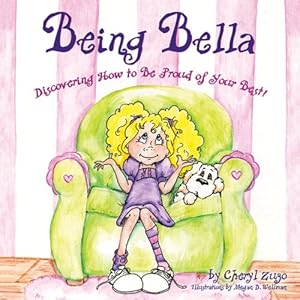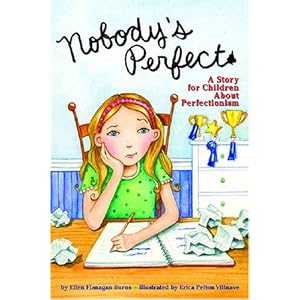Perfectionism is a trait that many gifted children experience. Sometimes it is due to a child's internal perceptions and personal motivations while other times it is due to external circumstances or situations. Below are some books that are useful for helping lower-elementary gifted school children with their perfectionism.
The best part about this picture book is that it reiterates the number one most important aspect of my teaching philosophy: Always do your best! In fact, I believe so strongly in working towards your personal best that it is also my first classroom rule. This picture book is a great read-aloud for an entire class or for an individual student struggling with perfectionism.
From a whole-class standpoint, it reaches the perfectionist child, but also shows his/her peers what someone experiencing perfection might feel like to informally teach empathy. It also teaches the entire class why you shouldn’t laugh when someone makes a mistake.
For a young child struggling with perfection, this book is perfect. The story line is simple yet powerful as a little girl (Bella) makes a big deal when she cannot do things absolutely perfectly. Everyone tells her “Just do your best, Bella” and she soon realizes that she can do anything when she tries her best and it doesn’t have to be perfect. In the last part of the book, Bella is sharing her “new found wisdom” with her friends and family, further demonstrating that no one is perfect and no one expects her to be either.
Within this story, Vashti sits through the entire art class without doing anything because she doesn’t think she can draw. With her teacher’s encouragement, she stabs a marker onto her paper and writes her name. Her teacher facilitates this attempt by framing her picture behind her desk, portraying to Vashti that she only has to try. This encourages Vashti, who eventually makes an entire art gallery of dots to display at her school’s art show. In the end, the story comes full circle because she inspires other children.
This has been one of my favorite books since my elementary literature class in college. I have read it so many times that I have practically memorized it and am constantly recommending it to teachers I meet at conferences or in passing. Every year I read it to my students during the first week of school when reviewing our class rules because I feel that the message is remarkable: Just try your best.
After becoming a teacher at a school for gifted students, I realized how powerful this book truly is and how similar Vashti is to children I teach every day. I now read this book several times a year and incorporate it into several subject areas. Perfection is not an obvious, outspoken theme in this book like other books I have listed. Instead, it is a subtle characteristic of the main character portrayed through the frustration that children can relate to. I have seen this book change the perceptions of many of my students with perfectionism when writing. Many times they only write a few words when their head is full of ideas because they do not want to misspell anything. Other times they have a blank paper because they can’t think of any ideas. I always refer to this book and tell them, “Just make a mark and see where it takes you.” This usually prompts a smile and encouragement.
I have created several discussion questions below that can be used with this book. They can be used in whole-group, small-group, or individual settings. Because picture books are so short, I recommend using the discussion questions at the end of the story. I also recommend gauging the child/children’s responses to the questions, as you may not need to discuss all questions. Lastly, I have found it helpful to tape the questions inside the back cover for students use when reading and reflecting individually.
Discussion Questions
1. Why didn’t Vashti want to make a mark? Have you ever felt scared to try something new? When?
2. What happened to Vashti after she made a mark? How do you think she felt?
3. Have you ever felt relieved after trying something you didn’t think you could do? Why did yotu feel that way?
4. What impact did Vashti have on other children? Why?
5. How did the teacher know to tell Vashti to “Just make a mark?” How do you think the teacher felt when Vashti had an empty paper at the end of class?
Below is a video reading of the book The Dot. Enjoy!
Written by the same author as The Dot, Ish is an inspiring story about a little boy, Ramon, who loved to draw. One day, his older brother laughed at one of his drawings and Ramon’s concept of himself and his drawings was never the same. He became so critical and “perfectionistic” about his drawings that he continually crumpled them up until deciding to quit drawing. His sister became his new-found inspiration by telling him that things can look “ish.” The flexibility that “ish” provided was exhilarating and Ramon began drawing and writing again without ever looking back.
This book is a great inspiration for gifted children who struggle with achieving a sense of perfection that is self-driven due to another person’s negative reaction and/or remarks. The book shows Ramon’s emotions in a way that children can identify with as their perfection is validated through a similar experience by a fictional character. However, it also gives children a different perspective on their perfection by demonstrating that perfection is not necessary with the “ish outlook.” I like the way Reynolds also explains how Ramon feels after adopting the “ish outlook,” making Ramon easier to relate with.
With this book, I have written discussion questions. I recommend using the questions while reading the story, as some answers are revealed by the author (eliminating personal insight and critical thinking) as the story continues. However, they can be discussed after reading the entire book if needed. When using the questions while reading the story, stop and discuss the questions after the page provided in parentheses.
Discussion Questions:
1. How do you think Ramon feels after his brother laughs at his drawing? Why? (pg. 6)
2. Have you ever felt like that? When? What happened? What did you do? (pg. 6)
3. Why does Ramon quit? Have you ever quit something you loved? Does quitting make you feel better or worse? Why? (pg. 10)
4. Why does “ish” change Ramon’s perspective? Could thinking “ish” about something you have trouble with change your abilities or decision to quit? Why? (pg. 20)
Below is a short video of me reading the book Ish.


